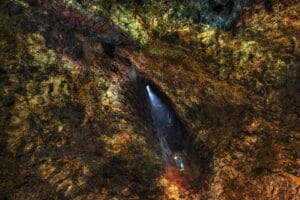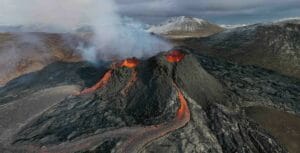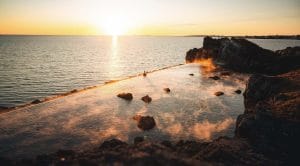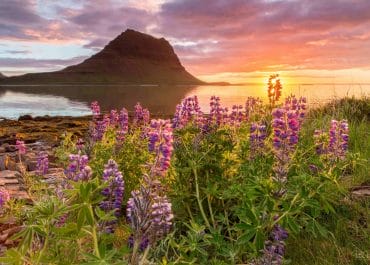Over the last two decades, Iceland has become one of the most popular destinations for travelers who seek the beauty and rawness of mother nature. It is no surprise that every year as many as 2 million tourists from all over the world visit this beautiful land of diverse and exotic flora and fauna. Some visit this country for its waterfalls, some for the spectacular view of northern lights, some for its world-famous cuisine, and others just want to explore its geological beauty. For Geology enthusiasts, Iceland is a heavenly garden. There is so much to see, so much to study, and just adore the natural beauty of the place.
In this blog, we are going to talk about the Geology of Iceland. It is a country with some of the most incredible and majestic geological sites and it is the land of frequent geothermal and volcanic activities. So let’s dive in to explore and know more about this beautiful country from the eyes of a geology enthusiast. We bet that by the end of this blog, all your questions regarding the Geological features of Iceland would be answered. And the cheery on top, we hope that this will motivate you to get out of your house and explore as much as you can, and travel without limits.

The Geological History of Iceland
To understand the beautiful scenic beauty of Iceland from the eyes of a Geologist, the first thing that we need to do is know more about the history of this land. We have to understand how Iceland was formed and how things took a turn to make it into heaven it is. Experts split the formation period of Iceland into three major parts. The most ancient of all these parts is the Tertiary Granite Formation that happened somewhere around 16-18 million years ago. It was formed when a volcanic eruption under the sea threw magma out and eventually it turned solid. The solid magma part of Iceland can be found in the Westfjords area. Then came the second wave of formation somewhere around 3 million years ago. This time the eruption was underneath the ice surface and it created what we know as famous tuff and dolerite mountains. After this came the third and last way that created Iceland as we see it. This came with melting ice some 10,000 years ago. This was the stage when modern lava as we know it came into existence and started flowing. Lava fields like those can still be seen in different parts of the country. In fact, you can see these lava fields while driving to and from the airport.

Volcanism
As you may already know, Iceland comes on the list of most active volcanic regions of the earth. In this region, almost every type of volcanic and geothermal phenomenon can be seen. The reason behind this is the combination of Iceland plume hotspot activity with the Mid-Atlantic Ridge activity. Due to the frequent and long processes of volcanism over millions of years, landscapes like rift valleys, hot springs, rhyolite mountains, basalt formations, lava fields, and craters similar to the craters on the moon are in abundance in this beautiful country. Iceland falls on the Mid-Atlantic Ridge, and slowly it is being split into two pieces by the movements of shifting tectonic plates. Both the plates are moving apart resulting in the movement of both the North American as well as Eurasian systems towards the northwest. On top of hotspots formed, there are molten layers at the depth of 5-20 kilometers, and these layers provide lava for volcanic eruptions. Iceland is home to as many as 100 volcanoes, and out of these some 35 have erupted in recent history. These eruptions occur in the gap of almost 5-10 years and with them comes the basaltic lava and tephra. Some of the most active areas of fresh crust formation can be found in south-western Iceland. The best thing about these areas is that they are completely accessible to tourists and every year, enthusiasts and tourists from all over the world come to see and study these natural marvels.
If you are willing to explore more, then a trip from Keflavik to Reykjavik can prove to be very rewarding for you as it takes you along the edge of the North American plate, through the meeting point of the Eurasian plate. From there you can drive to the Thingvellir National Park, which is also the site of the world’s first parliament, and see the older part of the rift system. It is indeed a breathtaking place as from here, you can see both sides of the plates’ boundary in one single view. This sweeping panorama attracts photographers and travelers from all over the world to capture this marvel of mother nature. If you are willing to explore more, then you can take a flight or a ferry to the island of Heimaey in the Westman Islands and take a glimpse of the new land that is being formed and the hazards and dangers of living in the mouth of a spreading rift.

Hot Springs & Geysers
Geysers and hot springs are some of the most popular and most visited tourist attractions of all in Iceland. Every year tourists from all over the world come to see and experience these wonders of mother nature. Geysers are found in geothermal areas of high temperature that come under the zone of volcanism and active rifting. The temperatures of hot springs that are found in these areas are generally up to 100°C and a large number of these springs are always boiling. When the temperature in the depth of these hot springs rises above the boiling temperature then eruption occurs. Since the water on the surface remains in contact with the cold air of the atmosphere, the boiling water in the depth gets trapped under the cold water and causes the explosion.
For centuries, these eruptions were considered a supernatural phenomenon until scientists explained the thermal activity behind these eruptions.
Below are some of the most famous geysers of Iceland.

The Great Geysir
The Golden Circle is one of the most famous and popular sightseeing tours in Iceland. The Great Geysir is the topmost attraction of this tour. You may find it very strange but every hot spring in the world is named after this one Icelandic hot spring. The almost every language of the world, the word “Geyser” or “Geysir” is used to refer to the phenomenon, but in the Icelandic language, it is used to refer to this particular geyser. In other words, there is only one real Geyser or Geysir in the world and that is The Great Geysir of Iceland, every other geyser just carries the name of this natural marvel.
According to the historical works and tales, the first story of Great Geysir can be traced back to the year 1294 when the southern lowland region of Iceland was shaken by a powerful earthquake and that resulted in a drastic change in the geothermal area of Haukadalur valley happened. According to historical texts, it was then when these hot springs erupted and were discovered. Over the centuries, the fame of The Great Geysir increased and the area became popular and famous for its hot springs all over the world. After 1294, the intensity of the thermal areas in this region gradually increased due to large earthquakes that strike the region almost every 100 years. The Great Geysir was dormant for a long period and became active when an earthquake of 6.5 magnitudes on the Richter scale hit the region on 17 June 2000, which was coincidently also Iceland’s national day.
Strokkur
Another major Geyser called Strokkur – is located at a distance of fewer than 100 meters away from the Great Geysir and it constantly keeps erupting almost every 4 to 8 minutes. Strokkur is a fountain geyser and has its name in one of the most famous Geysers of Iceland. It is one of the few geysers that erupt so frequently and that is the reason why it is the perfect tourist spot. Researchers and travelers from all over the world come to see this Geyser from all over the world every year. It was first mentioned in the year 1789 and it spouts steaming hot water up to the height of about 20 meters.
Other Geysers of Iceland
Apart from The Great Geysir and Strokkur, the Haukadalur area of south-western Iceland is home to a large number of smaller geysers. These geysers offer a wonderful view as some of these are colorful and constantly active. The perfect walking destination, many walking paths lead to these hot springs and silica deposits. While walking, you can feel the heat underneath your feet and you tread through the beautiful and captivating landscape.

The Blue Lagoon
This is one of the places in Iceland that do not need any introduction. The Blue Lagoon is the most famous landmark of Iceland and travelers from different parts of the world visit this place for its captivating beauty and for taking a dip in its healing water. It is located on the geothermally active region of the Reykjanes Peninsula and believe it or not, it was found by accident. This pool is made from run-off water from a nearby geothermal plant. This place gets its beauty from the turquoise blue water spring surrounded by black lava, and it’s extremely captivating to the eyes. Over the years as The Blue Lagoon became a popular tourist destination, the facilities around this place have been upgraded, and now there are different means of leisure like an in-water bar, restaurants, in-water massages, hotel, and many more facilities. But one thing that has remained the same at this play is the blue healing water.
The turquoise blue water of this pool comes from algae and silica present in the water. The water of this lagoon is medically proven to cure many diseases like psoriasis and different types of eczema. Even a single dip in The Blue Lagoon will make you feel refreshed and take away even the last bit of fatigue and tiredness that you get from traveling. The natural healing powers of this place makes one feel light and rejuvenating effects. The layer of silica works like a natural moisturizer and makes the skin as soft as a feather.

Reykjadalur - The Smokey Valley
Reykjadalur valley, popularly known as The Smokey Valley by non-Icelandic speaking travelers is located at a distance of only 45 minutes from the capital city. This place is like heaven for a Geology enthusiast as it is not just the perfect tourist spot, but also the perfect spot to study and understand the Geology of Iceland. This valley is located near the town of Hveragerdi, which literally means geyser garden and you can hike to the valley from the town. This hike is very rewarding because all around you, during the hike, you will find steaming hot springs and small bubbling mud pools surrounded by multicolored algae, sulfur, and silica.
The valley gets if the popular name from unique smoky pillars that rise all around the hiking path. The tracks are made for the convenience of the visitors and it is very easy to follow them. This is the ideal place for visitors coming from other parts of the world as there are many tours organized to help visitors understand the geology of this place whilst hiking. It is advised to stay on the tracks and not wander around in this area as the grounds aren’t as safe as they look. There are many hidden mud pools in this area that are invisible to the eyes but are very dangerous in nature.
This 1-hour hike brings you to the most captivating and relaxing bathing area that is safe for people of all ages. The water of the river gets hotter with the height and at the end of the trail, you will find water that is at Jacuzzi temperature and ideal for bathing. The one-hour hike may sound exhausting but the bathing experience at the end of the hike makes it worthy of the time it takes. The hot water extracts the fatigue and tiredness from the body and given a therapeutic experience.
Iceland is a country that is home to a diverse range of natural marvels. Everything about this country, from its culture to its cuisine, from its flora to its fauna, and from its springs to its pools, is breathtaking and gives a unique experience to its visitor. If you are a Geology enthusiast who is willing to explore different regions of the world, who is willing to understand and experience the energy of natural marvels like Volcanoes, Hot Springs, lakes, Geysers, and whatnot, then Iceland is the perfect destination for you. Pack your bags and get ready, because Iceland will surely amaze you and motivate you to explore more and more.




















































